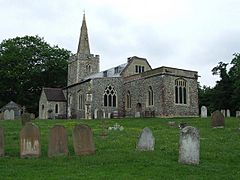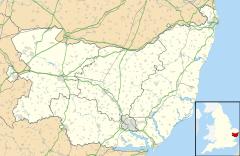Polstead facts for kids
Quick facts for kids Polstead |
|
|---|---|
 Church of St Mary, Polstead |
|
| Population | 851 (2011) |
| OS grid reference | TL991374 |
| Civil parish |
|
| District |
|
| Shire county | |
| Region | |
| Country | England |
| Sovereign state | United Kingdom |
| Post town | Colchester |
| Postcode district | CO6 |
| Dialling code | 01206 |
| Police | Suffolk |
| Fire | Suffolk |
| Ambulance | East of England |
| EU Parliament | East of England |
| UK Parliament |
|

Polstead is a charming village and civil parish located in the Babergh area of Suffolk, England. It sits about 3 kilometers (2 miles) northeast of Nayland. The village is also about 8 kilometers (5 miles) southwest of Hadleigh. Polstead is found near a small stream that flows into the River Stour. In 2011, about 851 people lived in the parish.
Contents
History of Polstead
The name Polstead means "Place by a pool." You can still find two large ponds in the village today.
The Red Barn Story
In 1827, Polstead was the site of a famous event known as the Red Barn Murder. The victim, Maria Marten, was later buried in the churchyard of St Mary's Church. Sadly, her gravestone was taken by people looking for souvenirs. Today, Maria Marten is remembered by a special sign near where her grave was. A local road, Marten's Lane, is also named after her.
Historic Buildings
The village church, St Mary's Church, was built in the 12th century. It features some very old bricks made in England. The church's tower dates back to the 14th century. It is the only tower in Suffolk that still has its original spire. Inside the church, you can see two old brass plaques. One of these plaques is for a priest and is dated 1460.
Right next to the churchyard is Polstead Hall. This large house was rebuilt around 1819 in the Georgian style. In the grounds of the hall, you can find the remains of the "Gospel Oak." This ancient tree finally fell down in 1953. People believe that Saint Cedd once preached under this tree. A new oak tree has been planted to replace the old one.
Village Features
The main part of Polstead is centered around Polstead Green and the Hill. However, Polstead also includes several smaller areas called hamlets. These include Polstead Heath, Hadleigh Heath, Bower House Tye, Bell's Corner, Mill Street, and Whitestreet Green.
The village has a 17th-century pub called The Cock Inn. There is also a community shop and a post office. Polstead has a playing field where an annual music festival takes place. This festival, called "Polstice," happens around the summer solstice. In the 1800s, a two-day fair was held on Polstead Green.
Polstead is also well-known for its cherries. A type of cherry, the Polstead Black, is named after the village. In recent years, more Polstead Black cherry trees have been planted. This helps to bring back these special trees, which had become less common.
Bower House Tye
Bower House Tye is a small hamlet located near the A1071 road. It is part of the Polstead parish. This area has five buildings that are officially "Listed." This means they are important historic buildings. These include Bower House, Brewery Farmhouse, Holly Cottage, and two Holmwood Cottages.
Hadleigh Heath
A Baptist chapel was built in Hadleigh Heath in 1801. It was later moved to Polstead in 1849.
Polstead Heath
A Primitive Methodist chapel was built in Polstead Heath in 1838.
Notable People from Polstead
Many interesting people have lived in Polstead over the years:
- Sir (Frank) Patrick Bishop (1900–1972) was an advertising writer and a politician.
- Eric Buckley (1868–1948) was a church leader who served as Rector of Polstead.
- Air Chief Marshal Sir Gareth Clayton (1914–1992) was a senior officer in the Royal Air Force.
- Percy Edwards (1908–1996) was famous for making animal sounds and was an entertainer.
- Simon Gales (born 1964) is a modern artist.
- R. P. Keigwin (1883–1972) was an academic and a cricketer.
- Ruth Rendell, Baroness Rendell of Babergh, CBE (1930-2015) was a well-known author. She wrote thrilling mystery novels.
See also
 In Spanish: Polstead para niños
In Spanish: Polstead para niños




